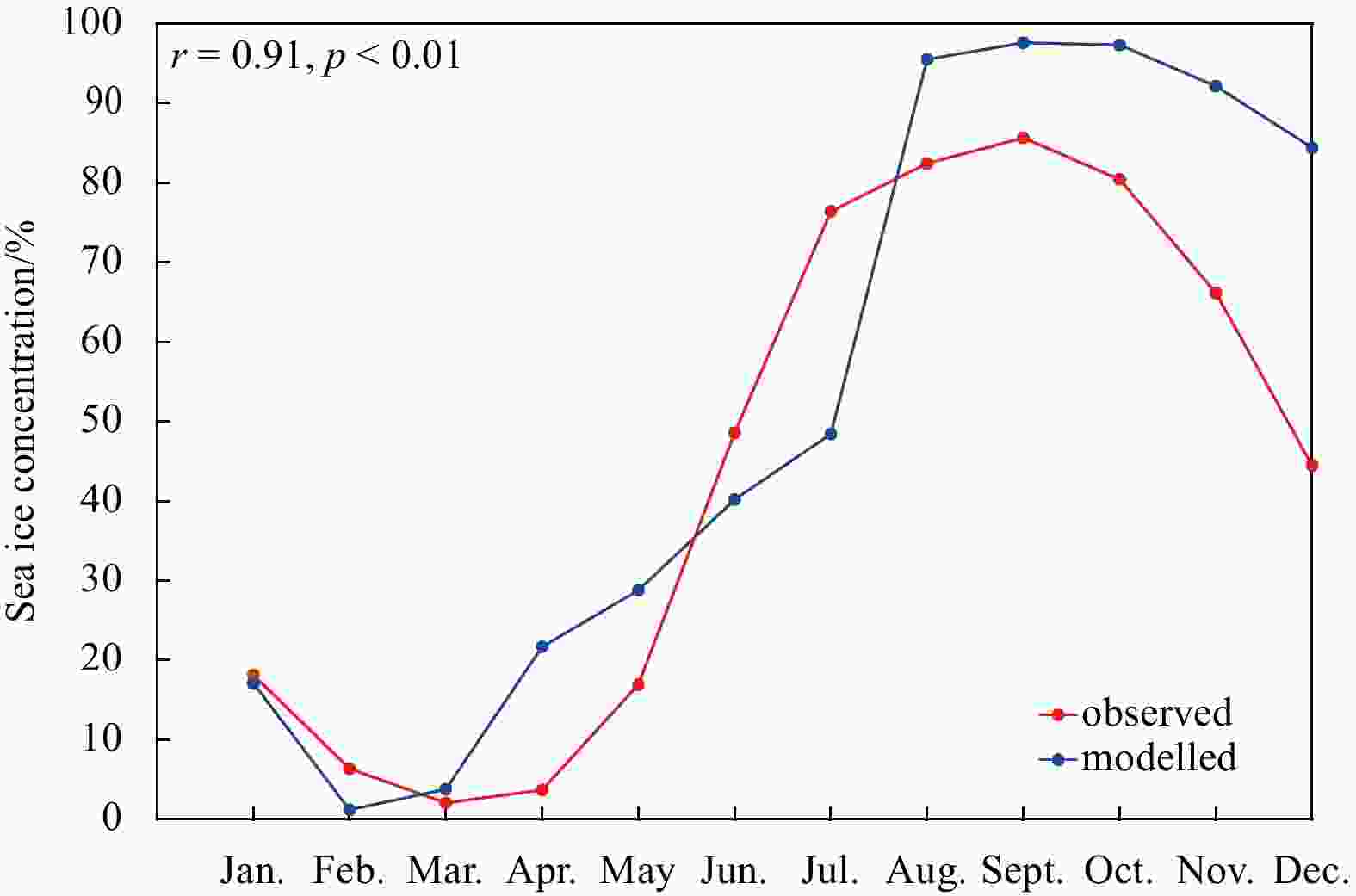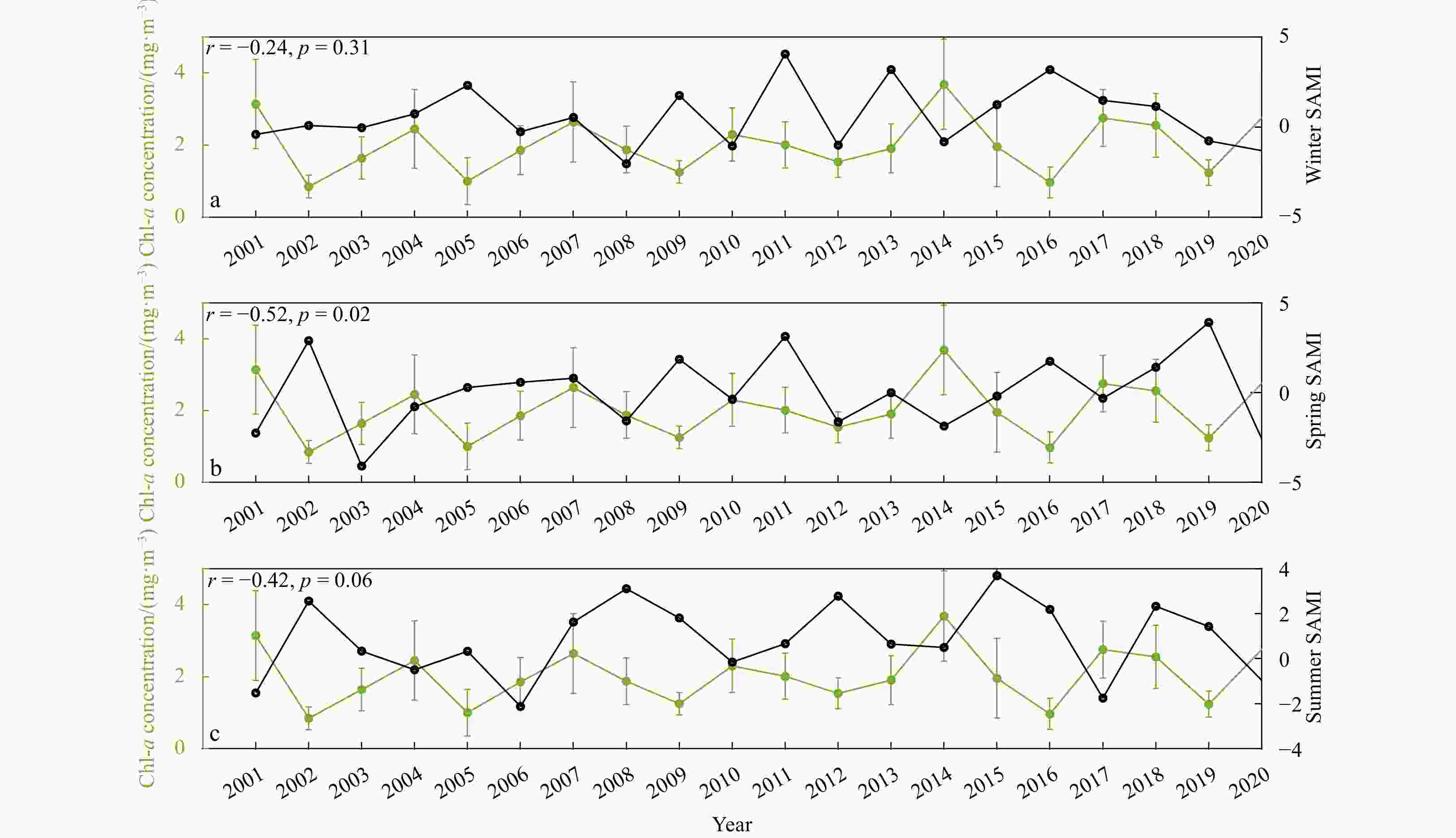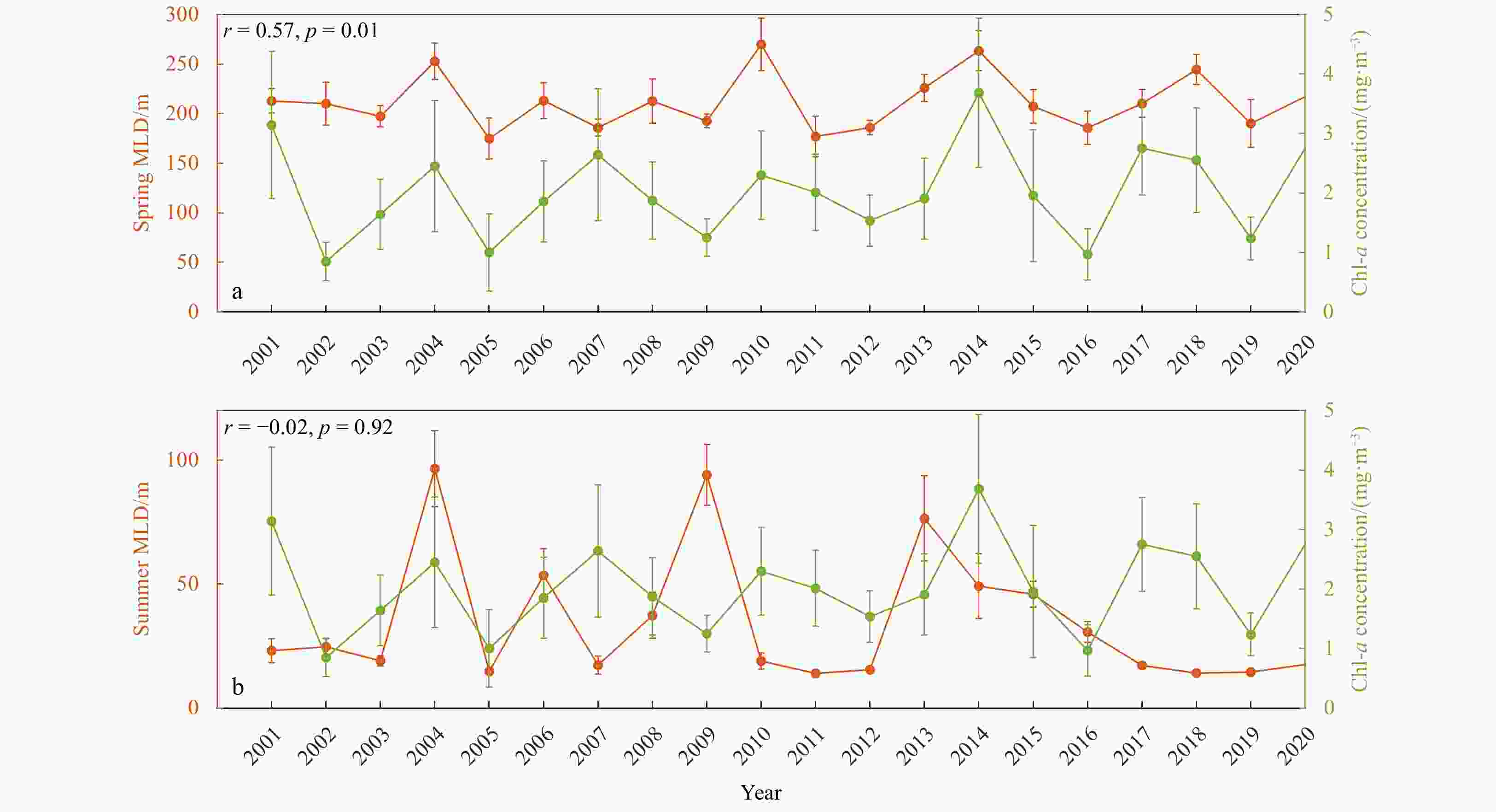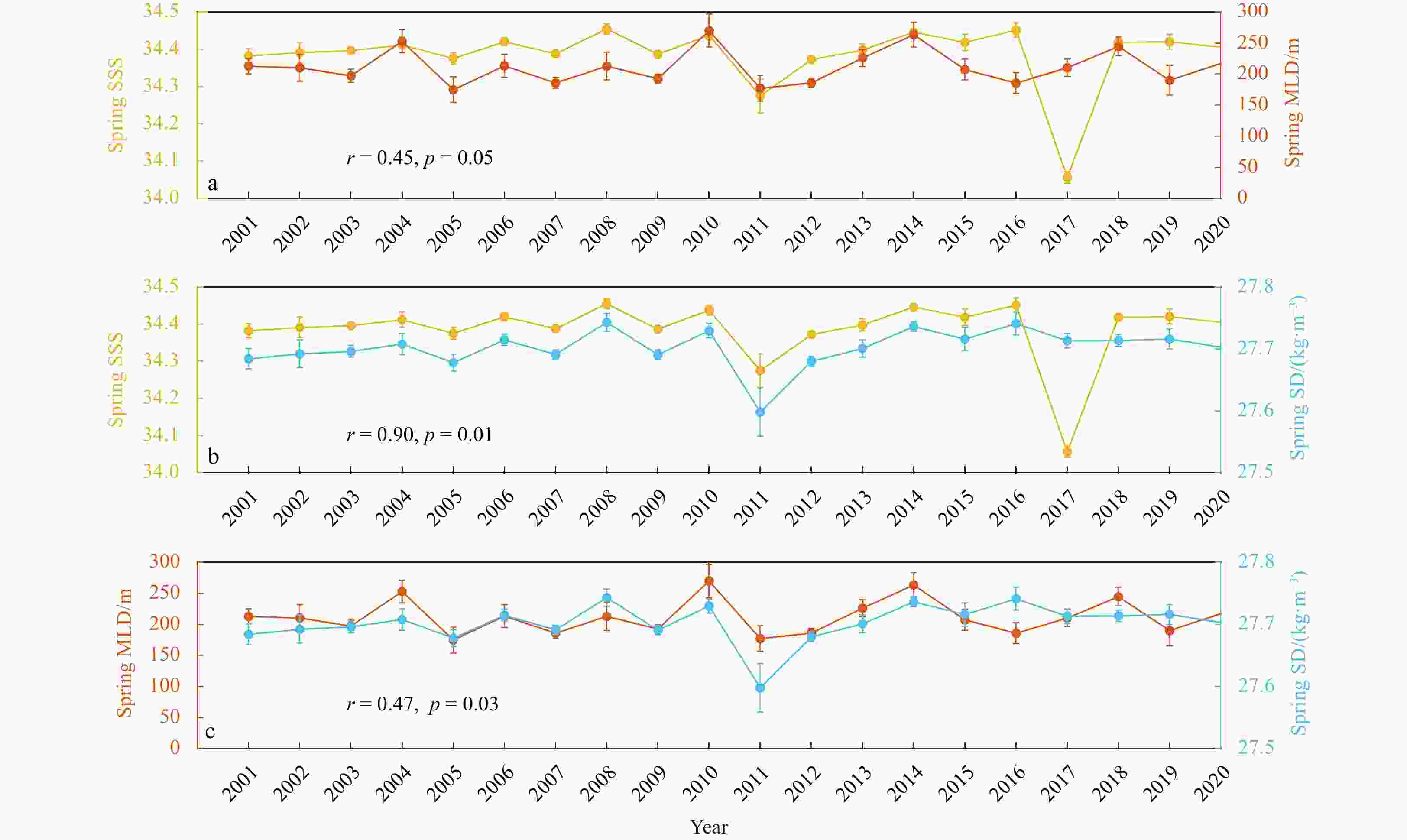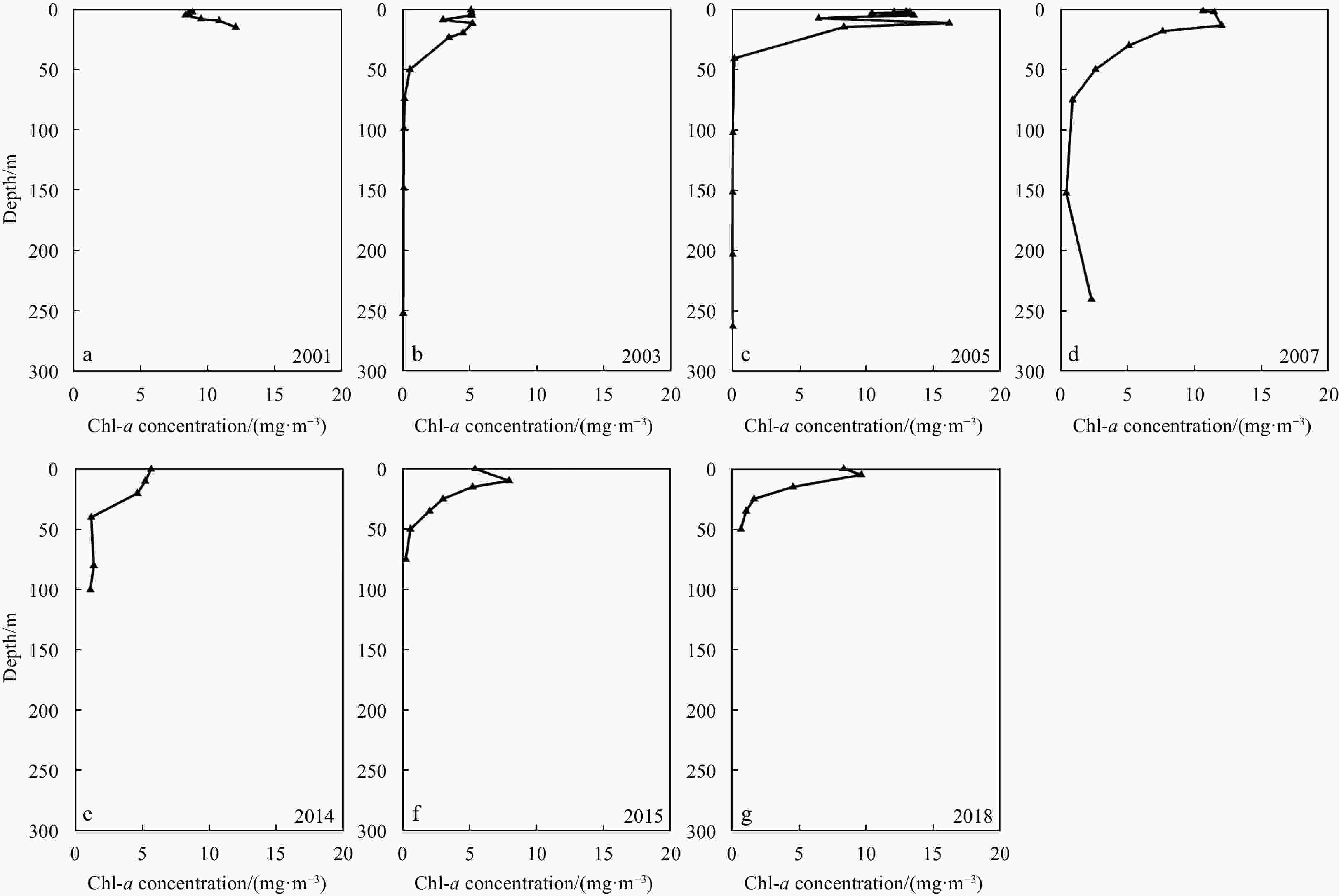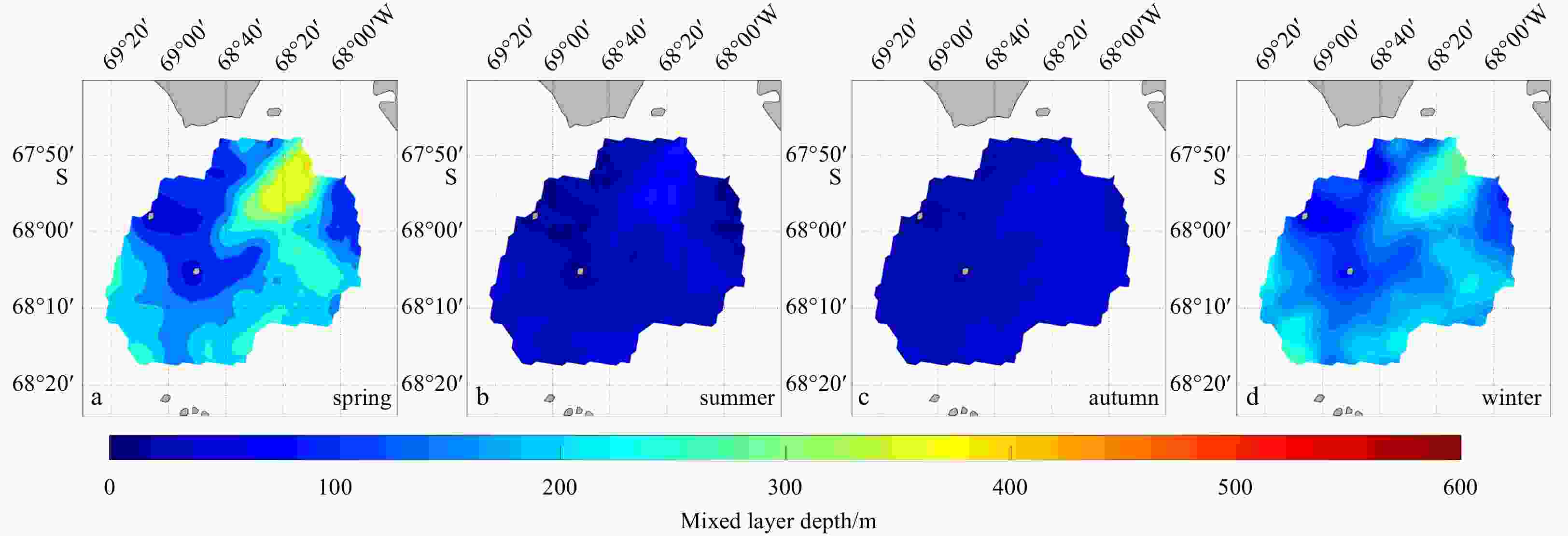The connection of phytoplankton biomass in the Marguerite Bay polynya of the western Antarctic Peninsula to the Southern Annular Mode
-
Abstract: Antarctic coastal polynyas are biological hotspots in the Southern Ocean that support the abundance of high-trophic-level predators and are important for carbon cycling in the high-latitude oceans. In this study, we examined the interannual variation of summertime phytoplankton biomass in the Marguerite Bay polynya (MBP) in the western Antarctic Peninsula area, and linked such variability to the Southern Annular Mode (SAM) that dominated the southern hemisphere extratropical climate variability. Combining satellite data, atmosphere reanalysis products and numerical simulations, we found that the interannual variation of summer chlorophyll-a (Chl-a) concentration in the MBP is significantly and negatively correlated with the spring SAM index, and weakly correlated with the summer SAM index. The negative relation between summer Chl-a and spring SAM is due to weaker spring vertical mixing under a more positive SAM condition, which would inhibit the supply of iron from deep layers into the surface euphotic layer. The negative relation between spring mixing and spring SAM results from greater precipitation rate over the MBP region in positive SAM phase, which leads to lower salinity in the ocean surface layer. The coupled physical-biological mechanisms between SAM and phytoplankton biomass revealed in this study is important for us to predict the future variations of phytoplankton biomasses in Antarctic polynyas under climate change.
-
Figure 1. Location of the numerical model domain in the Southern Ocean (red box) (a), location of the Marguerite Bay polynya area in the model domain (red box) (b), and distribution of the satellite-observed summer-mean sea ice concentration in the Marguerite Bay averaged over 2001–2020 (c). The white dashed rectangle represents the selected box enclosing the polynya, and the red line represents the 20% contour of sea ice concentration. The Pal LTER CTD sampling stations within the polynya area are shown by the plus markers (yellow: 2001; blue: 2002; black: 2003; red: 2004; green: 2005 and 2015; white: 2007, 2008, 2011 and 2017; purple: 2014 and 2018. Stations in different years labeled by the same color are very close to each other, but not at the exact locations). Temperature and salinity data were collected at all stations in the 12 years mentioned above, while Chl-a data were only collected in 2001, 2003, 2005, 2007, 2014, 2015 and 2018.
Figure 2. Taylor diagrams of comparisons between modelled and observed physical parameters in the Marguerite Bay polynya. a. The comparison between modelled and observed temperature (from Pal LTER; Fig. 1). b. The comparison between modelled and observed salinity (from Pal LTER). c. The comparison between modelled and calculated mixed layer depth (MLD) based on temperature and salinity in-situ measurements. d. The comparison between modelled and satellite-observed spring sea ice concentration (SIC). e. The comparison between modelled and satellite-observed summer sea ice concentration. f. The comparison between modelled and satellite-observed summer sea surface temperature (SST). The red plus markers indicate the information of correlation coefficients, standard deviations and root mean square errors of the modeled data; the closer they are to the observations (Obs), the smaller the errors between the modeled and observed data are.
Figure 4. Time series of the satellite-observed summer-mean chlorophyll-a (Chl-a) concentration averaged over the Marguerite Bay polynya (green lines) and the winter (a), spring (b), and summer (c) SAM indices (SAMI; black lines) for 2001–2020. The correlation coefficients, p-values, and standard deviations of Chl-a concentration (vertical bars) are shown.
Figure 6. Spatial distributions of the modelled spring-mean mixed layer depth (MLD) in the Marguerite Bay polynya during years with low spring SAM index (SAMI) (a–e) and high spring SAM index (f–j), and time series of spring SAM index and spring MLD in the MBP for 2001–2020 (k). In a–j, the SAM indices are labeled in the upper left corner of the panels. In k, the correlation coefficient, p-value, and standard deviations of MLD (vertical bars) are also shown.
Figure 7. Time series of the modelled spring-mean sea surface salinity (SSS) and mixed layer depth (MLD) (a), SSS and surface density (SD) (b), and MLD and surface density (c) in the Marguerite Bay polynya for 2001–2020. The correlation coefficients, p-values, and standard deviations (vertical bars) are shown.
Figure 8. Time series of spring-mean precipitation (from ERA5) and sea surface salinity (SSS; modelled) (a), precipitation and SAM index (SAMI) (b), precipitation and surface air temperature (SAT; from ERA5) (c), and SAT and SAMI (d) for the Marguerite Bay polynya during 2001–2020. The correlation coefficients, p-values, and standard deviations (vertical bars) are shown.
Figure 9. The vertical profiles of chlorophyll-a (Chl-a) concentration at the 7 Pal LTER stations (Fig. 1) in 2001–2018.
-
Annett A L, Fitzsimmons J N, Séguret M J M, et al. 2017. Controls on dissolved and particulate iron distributions in surface waters of the Western Antarctic Peninsula shelf. Marine Chemistry, 196: 81–97, doi: 10.1016/j.marchem.2017.06.004 Annett A L, Skiba M, Henley S F, et al. 2015. Comparative roles of upwelling and glacial iron sources in Ryder Bay, coastal western Antarctic Peninsula. Marine Chemistry, 176: 21–33, doi: 10.1016/j.marchem.2015.06.017 Arblaster J M, Meehl G A. 2006. Contributions of external forcings to southern annular mode trends. Journal of Climate, 19(12): 2896–2905, doi: 10.1175/JCLI3774.1 Ardelan M V, Holm-Hansen O, Hewes C D, et al. 2010. Natural iron enrichment around the Antarctic Peninsula in the Southern Ocean. Biogeosciences, 7(1): 11–25, doi: 10.5194/bg-7-11-2010 Arrigo K R, DiTullio G R, Dunbar R B, et al. 2000. Phytoplankton taxonomic variability in nutrient utilization and primary production in the Ross Sea. Journal of Geophysical Research: Oceans, 105(C4): 8827–8846, doi: 10.1029/1998JC000289 Arrigo K R, Mills M M, Kropuenske L R, et al. 2010. Photophysiology in two major Southern Ocean phytoplankton taxa: photosynthesis and growth of Phaeocystis antarctica and Fragilariopsis cylindrus under different irradiance levels. Integrative and Comparative Biology, 50(6): 950–966, doi: 10.1093/icb/icq021 Arrigo K R, van Dijken G L. 2003. Phytoplankton dynamics within 37 Antarctic coastal polynya systems. Journal of Geophysical Research: Oceans, 108(C8): 3271, doi: 10.1029/2002JC001739 Arrigo K R, van Dijken G L, Alderkamp A C, et al. 2017. Early spring phytoplankton dynamics in the western Antarctic Peninsula. Journal of Geophysical Research: Oceans, 122(12): 9350–9369, doi: 10.1002/2017JC013281 Arrigo K R, van Dijken G L, Strong A L. 2015. Environmental controls of marine productivity hot spots around Antarctica. Journal of Geophysical Research: Oceans, 120(8): 5545–5565, doi: 10.1002/2015JC010888 Atkinson A, Siegel V, Pakhomov E, et al. 2004. Long-term decline in krill stock and increase in salps within the Southern Ocean. Nature, 432(7013): 100–103, doi: 10.1038/nature02996 Becquevort S, Smith Jr W O. 2001. Aggregation, sedimentation and biodegradability of phytoplankton-derived material during spring in the Ross Sea, Antarctica. Deep-Sea Research Part II: Topical Studies in Oceanography, 48(19–20): 4155–4178 Bown J, Laan P, Ossebaar S, et al. 2017. Bioactive trace metal time series during Austral Summer in Ryder Bay, Western Antarctic Peninsula. Deep-Sea Research Part II: Topical Studies in Oceanography, 139: 103–119, doi: 10.1016/j.dsr2.2016.07.004 Bown J, van Haren H, Meredith M P, et al. 2018. Evidences of strong sources of DFe and DMn in Ryder Bay, western Antarctic Peninsula. Philosophical Transactions of the Royal Society A Mathematical, Physical and Engineering Sciences, 376(2122): 20170172 Bromwich D, Liu Z, Rogers A N, et al. 1998. Winter atmospheric forcing of the Ross Sea polynya. In: Jacobs S S, Weiss R F, eds. Ocean, Ice, and Atmosphere: Interactions at the Antarctic Continental Margin. Washington: American Geophysical Union, 101–133 Bromwich D H, Nicolas J P, Monaghan A J, et al. 2012. Central West Antarctica among the most rapidly warming regions on Earth. Nature Geoscience, 6(2): 139–145 Budgell W P. 2005. Numerical simulation of ice-ocean variability in the Barents Sea region. Ocean Dynamics, 55(3): 370–387 Budillon G, Fusco G, Spezie G. 2000. A study of surface heat fluxes in the Ross Sea (Antarctica). Antarctic Science, 12(2): 243–254, doi: 10.1017/S0954102000000298 Butler A H, Thompson D W J, Gurney K R. 2007. Observed relationships between the southern annular mode and atmospheric carbon dioxide. Global Biogeochemical Cycles, 21(4): GB4014 Clarke A, Meredith M P, Wallace M I, et al. 2008. Seasonal and interannual variability in temperature, chlorophyll and macronutrients in northern Marguerite Bay, Antarctica. Deep-Sea Research Part II: Topical Studies in Oceanography, 55(18–19): 1988–2006 Dare R A, Atkinson B W. 2000. Atmospheric response to spatial variations in concentration and size of polynyas in the Southern Ocean sea-ice zone. Boundary-Layer Meteorology, 94(1): 65–88, doi: 10.1023/A:1002442212593 Dinniman M S, Klinck J M, Hofmann E E. 2012. Sensitivity of Circumpolar Deep Water transport and ice shelf basal melt along the West Antarctic Peninsula to changes in the winds. Journal of Climate, 25(14): 4799–4816, doi: 10.1175/JCLI-D-11-00307.1 Dinniman M S, Klinck J M, Smith Jr W O. 2007. Influence of sea ice cover and icebergs on circulation and water mass formation in a numerical circulation model of the Ross Sea, Antarctica. Journal of Geophysical Research: Oceans, 112(C11): C11013, doi: 10.1029/2006JC004036 Dong Shenfu, Sprintall J, Gille S T, et al. 2008. Southern Ocean mixed-layer depth from Argo float profiles. Journal of Geophysical Research: Oceans, 113(C6): C06013 Ducklow H W, Fraser W R, Meredith M P, et al. 2013. West Antarctic Peninsula: an ice-dependent coastal marine ecosystem in transition. Oceanography, 26(3): 190–203, doi: 10.5670/oceanog.2013.62 Fairall C W, Bradley E F, Hare J E, et al. 2003. Bulk parameterization of air-sea fluxes: Updates and verification for the COARE algorithm. Journal of Climate, 16(4): 571–591, doi: 10.1175/1520-0442(2003)016<0571:BPOASF>2.0.CO;2 Fyfe J C. 2003. Separating extratropical zonal wind variability and mean change. Journal of Climate, 16(5): 863–874, doi: 10.1175/1520-0442(2003)016<0863:SEZWVA>2.0.CO;2 Garibotti I A, Vernet M, Ferrario M E, et al. 2003. Phytoplankton spatial distribution patterns along the western Antarctic Peninsula (Southern Ocean). Marine Ecology Progress Series, 261: 21–39, doi: 10.3354/meps261021 Gillett N P, Thompson D W J. 2003. Simulation of recent southern hemisphere climate change. Science, 302(5643): 273–275, doi: 10.1126/science.1087440 Graham J A, Dinniman M S, Klinck J M. 2016. Impact of model resolution for on-shelf heat transport along the West Antarctic Peninsula. Journal of Geophysical Research: Oceans, 121(10): 7880–7897, doi: 10.1002/2016JC011875 Gupta A S, England M H. 2006. Coupled ocean-atmosphere-ice response to variations in the southern annular mode. Journal of Climate, 19(18): 4457–4486, doi: 10.1175/JCLI3843.1 Haidvogel D B, Arango H, Budgell W P, et al. 2008. Ocean forecasting in terrain-following coordinates: Formulation and skill assessment of the Regional Ocean Modeling System. Journal of Computational Physics, 227(7): 3595–3624, doi: 10.1016/j.jcp.2007.06.016 Häkkinen S, Mellor G L. 1992. Modeling the seasonal variability of a coupled Arctic ice-ocean system. Journal of Geophysical Research: Oceans, 97(C12): 20285–20304, doi: 10.1029/92JC02037 Hall A, Visbeck M. 2002. Synchronous variability in the southern hemisphere atmosphere, sea ice, and ocean resulting from the annular mode. Journal of Climate, 15(21): 3043–3057, doi: 10.1175/1520-0442(2002)015<3043:SVITSH>2.0.CO;2 Hamre B, Stamnes J J, Frette B, et al. 2008. Could stratospheric ozone depletion lead to enhanced aquatic primary production in the polar regions?. Limnology and Oceanography, 53(1): 332–338, doi: 10.4319/lo.2008.53.1.0332 Hansen J, Ruedy R, Glascoe J, et al. 1999. GISS analysis of surface temperature change. Journal of Geophysical Research: Atmospheres, 104(D24): 30997–31022, doi: 10.1029/1999JD900835 Holland D M, Jenkins A. 1999. Modeling thermodynamic ice-ocean interactions at the base of an ice shelf. Journal of Physical Oceanography, 29(8): 1787–1800, doi: 10.1175/1520-0485(1999)029<1787:MTIOIA>2.0.CO;2 Huang Kuan, Ducklow H, Vernet M, et al. 2012. Export production and its regulating factors in the West Antarctica Peninsula region of the Southern Ocean. Global Biogeochemical Cycles, 26(2): GB2005 Hunke E C, Dukowicz J K. 1997. An elastic-viscous-plastic model for sea ice dynamics. Journal of Physical Oceanography, 27(9): 1849–1867, doi: 10.1175/1520-0485(1997)027<1849:AEVPMF>2.0.CO;2 Jiang Mingshun, Measures C I, Barbeau K A, et al. 2019. Fe sources and transport from the Antarctic Peninsula shelf to the southern Scotia Sea. Deep-Sea Research Part I: Oceanographic Research Papers, 150: 103060, doi: 10.1016/j.dsr.2019.06.006 Joy-Warren H L, van Dijken G L, Alderkamp A C, et al. 2019. Light is the primary driver of early season phytoplankton production along the western Antarctic Peninsula. Journal of Geophysical Research: Oceans, 124(11): 7375–7399, doi: 10.1029/2019JC015295 Karnovsky N, Ainley D G, Lee P. 2007. Chapter 12 the impact and importance of production in polynyas to top-trophic predators: Three case histories. Elsevier Oceanography Series, 74: 391–410 La H S, Park K. 2016. The Evident Role of Clouds on Phytoplankton Abundance in Antarctic Coastal Polynyas. Terrestrial Atmospheric and Oceanic Sciences, 27(2): 293–301, doi: 10.3319/TAO.2015.11.30.01(Oc Lefebvre W, Goosse H, Timmermann R, et al. 2004. Influence of the southern annular mode on the sea ice-ocean system. Journal of Geophysical Research: Oceans, 109(C9): C09005 Li Xichen, Cai Wenju, Meehl G A, et al. 2021. Tropical teleconnection impacts on Antarctic climate changes. Nature Reviews Earth & Environment, 2(10): 680–698 Li Yun, Ji Rubao, Jenouvrier S, et al. 2016. Synchronicity between ice retreat and phytoplankton bloom in circum-Antarctic polynyas. Geophysical Research Letters, 43(5): 2086–2093, doi: 10.1002/2016GL067937 Marini C, Frankignoul C, Mignot J. 2011. Links between the southern annular mode and the Atlantic meridional overturning circulation in a climate model. Journal of Climate, 24(3): 624–640, doi: 10.1175/2010JCLI3576.1 Marshall G J. 2003. Trends in the southern annular mode from observations and reanalyses. Journal of Climate, 16(24): 4134–4143, doi: 10.1175/1520-0442(2003)016<4134:TITSAM>2.0.CO;2 Marshall J, Speer K. 2012. Closure of the meridional overturning circulation through Southern Ocean upwelling. Nature Geoscience, 5(3): 171–180, doi: 10.1038/ngeo1391 Massom R A, Harris P T, Michael K J, et al. 1998. The distribution and formative processes of latent-heat polynyas in East Antarctica. Annals of Glaciology, 27: 420–426, doi: 10.3189/1998AoG27-1-420-426 Measures C I, Brown M T, Selph K E, et al. 2013. The influence of shelf processes in delivering dissolved iron to the HNLC waters of the Drake Passage, Antarctica. Deep-Sea Research Part II: Topical Studies in Oceanography, 90: 77–88, doi: 10.1016/j.dsr2.2012.11.004 Mellor G L, Kantha L. 1989. An ice-ocean coupled model. Journal of Geophysical Research: Oceans, 94(C8): 10937–10954, doi: 10.1029/JC094iC08p10937 Montes-Hugo M, Doney S C, Ducklow H W, et al. 2009. Recent changes in phytoplankton communities associated with rapid regional climate change along the western Antarctic peninsula. Science, 323(5920): 1470–1473, doi: 10.1126/science.1164533 Montes-Hugo M A, Yuan Xiaojun. 2012. Climate patterns and phytoplankton dynamics in Antarctic latent heat polynyas. Journal of Geophysical Research: Oceans, 117(C5): C05031 Moreau S, Mostajir B, Bélanger S, et al. 2015. Climate change enhances primary production in the western Antarctic Peninsula. Global Change Biology, 21(6): 2191–2205, doi: 10.1111/gcb.12878 Pezza A B, Rashid H A, Simmonds I. 2012. Climate links and recent extremes in Antarctic sea ice, high-latitude cyclones, southern annular mode and ENSO. Climate Dynamics, 38(1): 57–73 Planquette H, Sherrell R M, Stammerjohn S, et al. 2013. Particulate iron delivery to the water column of the Amundsen Sea, Antarctica. Marine Chemistry, 153: 15–30, doi: 10.1016/j.marchem.2013.04.006 Polvani L M, Waugh D W, Correa G J P, et al. 2011. Stratospheric ozone depletion: the main driver of twentieth-century atmospheric circulation changes in the southern hemisphere. Journal of Climate, 24(3): 795–812, doi: 10.1175/2010JCLI3772.1 Roberts A, Allison I, Lytle V I. 2001. Sensible- and latent-heat-flux estimates over the Mertz Glacier polynya, East Antarctica, from in-flight measurements. Annals of Glaciology, 33: 377–384, doi: 10.3189/172756401781818112 Saba G K, Fraser W R, Saba V S, et al. 2014. Winter and spring controls on the summer food web of the coastal West Antarctic Peninsula. Nature Communications, 5: 4318, doi: 10.1038/ncomms5318 Schmidtko S, Johnson G C, Lyman J M. 2013. MIMOC: A global monthly isopycnal upper-ocean climatology with mixed layers. Journal of Geophysical Research: Oceans, 118(4): 1658–1672, doi: 10.1002/jgrc.20122 Screen J A, Gillett N P, Karpechko A Y, et al. 2010. Mixed layer temperature response to the southern annular mode: mechanisms and model representation. Journal of Climate, 23(3): 664–678, doi: 10.1175/2009JCLI2976.1 Shchepetkin A F, McWilliams J C. 2009. Correction and commentary for “ocean forecasting in terrain-following coordinates: Formulation and skill assessment of the regional ocean modeling system” by Haidvogel et al., J. Comp. Phys. 227, pp. 3595–3624. Journal of Computational Physics, 228(24): 8985–9000, doi: 10.1016/j.jcp.2009.09.002 Simpkins G R, Ciasto L M, Thompson D W J, et al. 2012. Seasonal relationships between large-scale climate variability and Antarctic sea ice concentration. Journal of Climate, 25(16): 5451–5469, doi: 10.1175/JCLI-D-11-00367.1 Smith Jr W, Gosselin M, Legendre L, et al. 1997. New production in the Northeast Water Polynya: 1993. Journal of Marine Systems, 10(1–4): 199–209 Smith R C, Martinson D G, Stammerjohn S E, et al. 2008. Bellingshausen and western Antarctic Peninsula region: pigment biomass and sea-ice spatial/temporal distributions and interannual variabilty. Deep-Sea Research Part II: Topical Studies in Oceanography, 55(18–19): 1949–1963 Spearman C. 1904. The proof and measurement of association between two things. The American Journal of Psychology, 15(1): 72–101, doi: 10.2307/1412159 Steele M, Mellor G L, McPhee M G. 1989. Role of the molecular sublayer in the melting or freezing of sea ice. Journal of Physical Oceanography, 19(1): 139–147, doi: 10.1175/1520-0485(1989)019<0139:ROTMSI>2.0.CO;2 Steinberg D K, Ruck K E, Gleiber M R, et al. 2015. Long-term (1993–2013) changes in macrozooplankton off the western Antarctic Peninsula. Deep-Sea Research Part I: Oceanographic Research Papers, 101: 54–70, doi: 10.1016/j.dsr.2015.02.009 Tagliabue A, Sallée J B, Bowie A R, et al. 2014. Surface-water iron supplies in the Southern Ocean sustained by deep winter mixing. Nature Geoscience, 7(4): 314–320, doi: 10.1038/ngeo2101 Talley L D. 2011. Descriptive Physical Oceanography: An Introduction. Amsterdam: Academic Press Tamura T, Ohshima K I, Fraser A D, et al. 2016. Sea ice production variability in Antarctic coastal polynyas. Journal of Geophysical Research: Oceans, 121(5): 2967–2979, doi: 10.1002/2015JC011537 Taylor K E. 2001. Summarizing multiple aspects of model performance in a single diagram. Journal of Geophysical Research: Atmospheres, 106(D7): 7183–7192, doi: 10.1029/2000JD900719 Thompson D W J, Wallace J M. 2000. Annular modes in the extratropical circulation. Part I: Month-to-month variability. Journal of Climate, 13(5): 1000–1016, doi: 10.1175/1520-0442(2000)013<1000:AMITEC>2.0.CO;2 Turner J, Phillips T, Hosking J S, et al. 2013. The Amundsen Sea Low. International Journal of Climatology, 33(7): 1818–1829, doi: 10.1002/joc.3558 Vernet M, Martinson D, Iannuzzi R, et al. 2008. Primary production within the sea-ice zone west of the Antarctic Peninsula: I-sea ice, summer mixed layer, and irradiance. Deep-Sea Research Part II: Topical Studies in Oceanography, 55(18/19): 2068–2085 Zhang Zhaoru, Hofmann E E, Dinniman M S, et al. 2020. Linkage of the physical environments in the northern Antarctic Peninsula region to the Southern Annular Mode and the implications for the phytoplankton production. Progress in Oceanography, 188: 102416, doi: 10.1016/j.pocean.2020.102416 Zhang Zhaoru, Uotila P, Stössel A, et al. 2018. Seasonal southern hemisphere multi-variable reflection of the southern annular mode in atmosphere and ocean reanalyses. Climate Dynamics, 50(3): 1451–1470 Zweng M M, Reagan J R, Antonov J I, et al. 2013. World Ocean Atlas 2013. Volume 2: Salinity. In: Levitus S, Mishonov A, ed. NOAA Atlas NESDIS74. Washington: Government Printing Office -





 下载:
下载:

